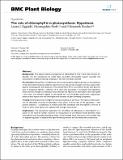| dc.contributor.author | Park, Hyoungshin | |
| dc.contributor.author | Hoober, J. Kenneth | |
| dc.contributor.author | Eggink, Laura L. | |
| dc.date.accessioned | 2010-09-29T15:16:53Z | |
| dc.date.available | 2010-09-29T15:16:53Z | |
| dc.date.issued | 2001-10 | |
| dc.date.submitted | 2001-07 | |
| dc.identifier.issn | 1471-2229 | |
| dc.identifier.uri | http://hdl.handle.net/1721.1/58754 | |
| dc.description.abstract | Background The physico-chemical properties of chlorophylls b and c have been known for decades. Yet the mechanisms by which these secondary chlorophylls support assembly and accumulation of light-harvesting complexes in vivo have not been resolved. Presentation Biosynthetic modifications that introduce electronegative groups on the periphery of the chlorophyll molecule withdraw electrons from the pyrrole nitrogens and thus reduce their basicity. Consequently, the tendency of the central Mg to form coordination bonds with electron pairs in exogenous ligands, a reflection of its Lewis acid properties, is increased. Our hypothesis states that the stronger coordination bonds between the Mg atom in chlorophyll b and chlorophyll c and amino acid sidechain ligands in chlorophyll a/b- and a/c-binding apoproteins, respectively, enhance their import into the chloroplast and assembly of light-harvesting complexes. Testing Several apoproteins of light-harvesting complexes, in particular, the major protein Lhcb1, are not detectable in leaves of chlorophyll b-less plants. A direct test of the hypothesis – with positive selection – is expression, in mutant plants that synthesize only chlorophyll a, of forms of Lhcb1 in which weak ligands are replaced with stronger Lewis bases. Implications The mechanistic explanation for the effects of deficiencies in chlorophyll b or c points to the need for further research on manipulation of coordination bonds between these chlorophylls and chlorophyll-binding proteins. Understanding these interactions will possibly lead to engineering plants to expand their light-harvesting antenna and ultimately their productivity. | en_US |
| dc.description.sponsorship | National Science Foundation (Graduate Training Grant DGE9553456) | en_US |
| dc.publisher | BioMed Central Ltd | en_US |
| dc.relation.isversionof | http://dx.doi.org/10.1186/1471-2229-1-2 | en_US |
| dc.rights | Creative Commons Attribution | en_US |
| dc.source | BioMed Central Ltd | en_US |
| dc.title | The role of chlorophyll b in photosynthesis: Hypothesis | en_US |
| dc.type | Article | en_US |
| dc.identifier.citation | Eggink, Laura, Hyoungshin Park, and J Kenneth Hoober. “The role of chlorophyll b in photosynthesis: Hypothesis.” BMC Plant Biology 1.1 (2001): 2. | en_US |
| dc.contributor.department | Harvard University--MIT Division of Health Sciences and Technology | en_US |
| dc.contributor.mitauthor | Park, Hyoungshin | |
| dc.relation.journal | BMC Plant Biology | en_US |
| dc.eprint.version | Final published version | en_US |
| dc.identifier.pmid | 11710960 | |
| dc.type.uri | http://purl.org/eprint/type/JournalArticle | en_US |
| eprint.status | http://purl.org/eprint/status/PeerReviewed | en_US |
| dc.date.updated | 2010-09-03T16:19:33Z | |
| dc.language.rfc3066 | en | |
| dc.rights.holder | Eggink et al.; licensee BioMed Central Ltd. | |
| dspace.orderedauthors | Eggink, Laura L; Park, Hyoungshin; Hoober, J Kenneth | en |
| mit.license | PUBLISHER_CC | en_US |
| mit.metadata.status | Complete | |
